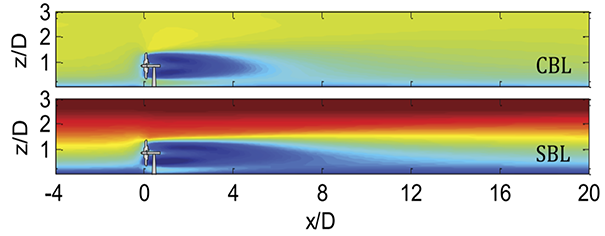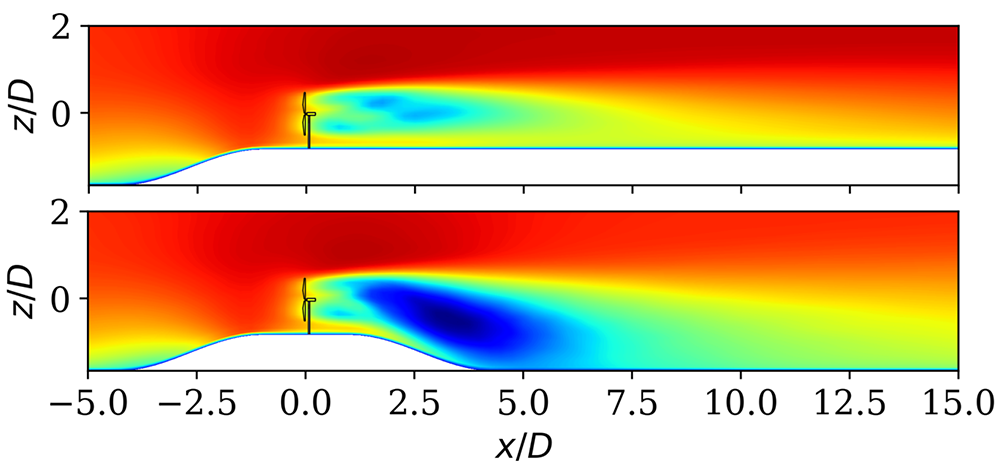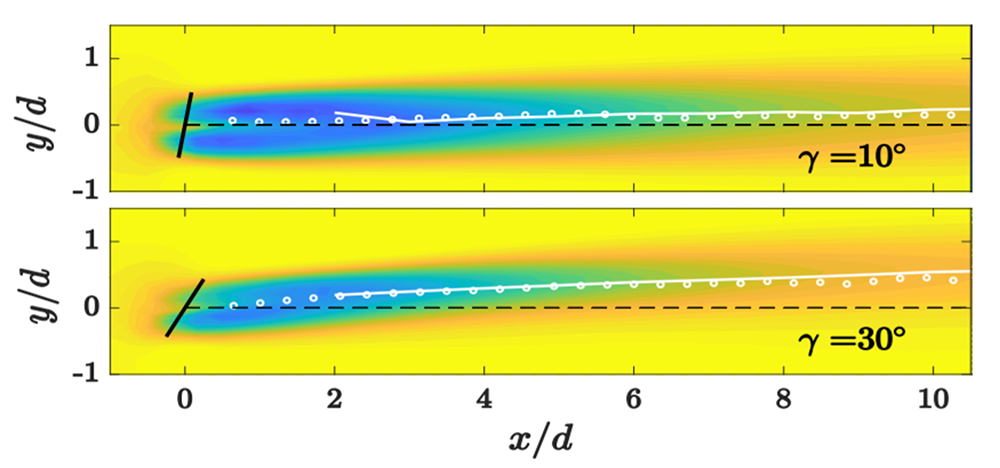General presentation of WiRE-LES Code
In wind farms, most of the turbines are operating in the wake of the upstream turbines. Therefore, the study of wind turbine wakes and their complex interactions with the atmospheric boundary layer is crucial for the development of wind energy. For example, the cumulated velocity deficit and the added turbulence effects in wind farms can be responsible for important power losses and structural loads, and a better understanding of these phenomena is necessary to improve existing and future wind farms.
In this context, WiRE lab develops a Large-Eddy Simulation (LES) code dedicated to atmospheric flows and oriented towards wind energy applications. LES is the state-of-the-art technique for turbulent resolving simulations of atmospheric flows. By resolving the largest most energetic eddies and modelling only the smallest ones, LES allow to solve most of the turbulent phenomena involved, providing precious information and high accuracy. The in-house code, named WiRE-LES, can serve as a numerical tool to study the turbine wake flow interaction with the turbulent atmospheric boundary layer, as for example:
Effect of the incoming turbulence level

Effect of the atmospheric stability

Effect of the topography

Wind turbine wake in yawed condition

The cohabitation in the lab between the experimental wind tunnel and the LES code is particularly interesting: experimental studies allow to validate WiRE-LES code which can then be used for field scale problems that are not easily studied experimentally.
Following is a brief introduction of the technical aspects of the WiRE-LES code. A detailed description of each section can be found in the provide reference section
General, Flow solver, Discretization
The WiRE-LES code solves the filtered incompressible Navier-Stokes equations. The code is based on pseudo-spectral schemes in the horizontal directions and 2nd order centered finite-difference scheme in the vertical direction. In addition, the code is dealiased by padding and truncation or explicit filtering, and the grid is staggered in the vertical direction. The projection method is used to enforce incompressibility and the pressure equation is solved exactly and efficiently thanks to the discretization (Fast Poisson Solver). Finally, the 2nd order Adams–Bashforth explicit scheme is used for time advancement.
Boundary conditions
As a consequence of discretization, horizontal boundary conditions are periodic. However, with the use of a precursor simulation and a buffer layer, a turbulent inflow can be imposed. Multiple boundary conditions can be applied at the top and bottom boundaries depending on the situation. Most of the time, a flux-free boundary condition is used at the top and local application of Monin–Obukhov similarity theory is used at the bottom.
Stability
The code can treat passive scalars, temperature (using the Boussinesq approximation) and moisture. Thanks to this, variation in the atmospheric stability conditions and its interaction with the wake flow has been studied in several contexts: (1) wake flow analysis under different stability conditions, (2) wind farm power analysis under different stability condition and (3) flow inside and above wind farm under diurnal cycle and free atmosphere stratification.
SGS modelling
The subgrid-scale (SGS) fluxes of momentum and scalars can be parameterized using one of the following models: traditional Smagorinsky model with damping, planar or Lagrangian dynamic model, planar or Lagrangian scale-dependent dynamic model (LASD), and modulated gradient model (MGM).
Topography
Specific versions of the code can handle topography, whether by terrain following coordinate transform (TFCT) or immersed boundary method (IBM).
Turbine modelling
The code allows to include turbines using actuator models. Horizontal axis wind turbine (HAWT) forces are parameterized using one of the following models: actuator disc without rotation (ADM-NR), actuator disc with rotation (ADM-R) and actuator line model (ALM). Specific versions of the ADM-NR and ADM-R are available to handle yawed wind turbines and turbines on topography. Vertical axis wind turbine (VAWT) forces are parameterized using one of the following models: actuator swept-surface model (ASSM) and actuator line model (ALM).
Implementation
The core of the code is programmed in Fortran 90 and a Python wrapper offers a user-friendly interface and embedded pre- and post-processing. The standard code is parallelized using slab decomposition and a new version of the code with pencil decomposition is in development. GPU implementation of the code is also an interesting direction for large scale problem which currently is a topic of interest in the lab.
References
Code Basics
- P. Moin et al. Large eddy simulation of incompressible turbulent channel flow. Technical report, NASA. 1978.
- CH Moeng. A Large-Eddy-Simulation Model for the Study of Planetary Boundary-Layer Turbulence. Journal of the Atmospheric Sciences. 1984.
- JD Albertson. Large Eddy Simulation of Land-atmosphere Interaction. PhD thesis, University of California, Davis. 1996.
- JD Albertson and MB Parlange. Surface length scales and shear stress: Implications for land‐atmosphere interaction over complex terrain. Water Resources Research. 1999.
- JD Albertson and MB Parlange. Natural integration of scalar fluxes from complex terrain. Water Resources Research. 1999.
Sub-grid Scale Modeling
- F Porté-Agel et al. A scale-dependent dynamic model for large-eddy simulation: application to a neutral atmospheric boundary layer. Journal of Fluid Mechanics. 2000.
- F Porté-Agel. A scale-dependent dynamic model for scalar transport in large-eddy simulations of the atmospheric boundary layer. Boundary-Layer Meteorology. 2004.
- R Stoll and F Porté‐Agel. Dynamic subgrid‐scale models for momentum and scalar fluxes in large‐eddy simulations of neutrally stratified atmospheric boundary layers over heterogeneous terrain. Water Resources Research. 2006.
- R Stoll and F Porté-Agel. Effect of roughness on surface boundary conditions for large-eddy simulation. Boundary-layer meteorology. 2006.
- R Stoll and F Porté-Agel. Large-eddy simulation of the stable atmospheric boundary layer using dynamic models with different averaging schemes. Boundary-layer meteorology, 2008.
- H Lu and F Porté-Agel. A modulated gradient model for large-eddy simulation: application to a neutral atmospheric boundary layer. Physics of Fluids. 2010.
- H Lu and F Porté-Agel. A modulated gradient model for scalar transport in large-eddy simulation of the atmospheric boundary layer. Physics of Fluids. 2013.
Horizontal Axis Wind Turbine Basics
- YT Wu and F Porté-Agel. Large-eddy simulation of wind-turbine wakes: evaluation of turbine parametrisations. Boundary-layer meteorology. 2011.
- F Porté-Agel et al. A large-eddy simulation framework for wind energy applications. The Fifth International Symposium on Computational Wind Engineering, CWE2010. 2010.
- F Porté-Agel et al. Large-eddy simulation of atmospheric boundary layer flow through wind turbines and wind farms. Journal of Wind Engineering and Industrial Aerodynamics. 2011.
- YT Wu and F Porté-Agel. Atmospheric turbulence effects on wind-turbine wakes: An LES study. Energies. 2012.
- YT Wu and F Porté-Agel. Simulation of turbulent flow inside and above wind farms: model validation and layout effects. Boundary-layer meteorology. 2013
- F Porté-Agel et al. A numerical study of the effects of wind direction on turbine wakes and power losses in a large wind farm. Energies. 2013.
- YT Wu and F Porté-Agel. Modeling turbine wakes and power losses within a wind farm using LES: An application to the Horns Rev offshore wind farm. Renewable Energy. 2015.
Horizontal Axis Wind Turbine & Stability
- H Lu and F Porté-Agel. Large-eddy simulation of a very large wind farm in a stable atmospheric boundary layer. Physics of Fluids. 2011.
- M Abkar and F Porté-Agel. The effect of free-atmosphere stratification on boundary-layer flow and power output from very large wind farms. Energies. 2013.
- M Abkar and F Porté-Agel. Mean and turbulent kinetic energy budgets inside and above very large wind farms under conventionally-neutral condition. Renewable Energy. 2014.
- H Lu and F Porté-Agel. On the impact of wind farms on a convective atmospheric boundary layer. Boundary-layer meteorology. 2015.
- M Abkar and F Porté-Agel. Influence of atmospheric stability on wind-turbine wakes: A large-eddy simulation study. Physics of fluids. 2015.
- M Abkar et al. Wake flow in a wind farm during a diurnal cycle. Journal of Turbulence. 2016.
Vertical Axis Wind Turbine Basics
- S Shamsoddin and F Porté-Agel. Large eddy simulation of vertical axis wind turbine wakes. Energies. 2014.
- S Shamsoddin and F Porté-Agel. A large-eddy simulation study of vertical axis wind turbine wakes in the atmospheric boundary layer. Energies. 2016.
- S Shamsoddin and F Porté-Agel. Effect of aspect ratio on vertical-axis wind turbine wakes. Journal of Fluid Mechanics. 2020.
Topography
- TL Clark A small-scale dynamic model using a terrain-following coordinate transformation. Journal of Computational Physics. 1977.
- F Wan et al. Evaluation of dynamic subgrid-scale models in large-eddy simulations of neutral turbulent flow over a two-dimensional sinusoidal hill. Atmospheric Environment. 2007.
- F Wan and F Porté-Agel. Large-eddy simulation of stably-stratified flow over a steep hill. Boundary-layer meteorology. 2011.
- J Fang et al. Towards oscillation-free implementation of the immersed boundary method with spectral-like methods. Journal of Computational Physics. 2011.
- M Diebold et al. Flow over Hills: A Large-Eddy Simulation of the Bolund Case. Boundary-layer meteorology. 2013.
- WC Cheng and F Porté-Agel.Evaluation of subgrid-scale models in large-eddy simulation of flow past a two-dimensional block. International journal of heat and fluid flow. 2013.
- WC Cheng and F Porté-Agel. Adjustment of turbulent boundary-layer flow to idealized urban surfaces: a large-eddy simulation study. Boundary-Layer Meteorology. 2015.
- WC Cheng and F Porté-Agel. Large-eddy simulation of flow and scalar dispersion in rural-to-urban transition regions. International Journal of Heat and Fluid Flow. 2016.
- J Fang and F Porté-Agel. Intercomparison of terrain-following coordinate transformation and immersed boundary methods in large-eddy simulation of wind fields over complex terrain. Journal of Physics: Conference Series. 2016.
- S Shamsoddin and F Porté-Agel. Large-eddy simulation of atmospheric boundary-layer flow through a wind farm sited on topography. Boundary-layer meteorology. 2017.
- S Shamsoddin and F Porté-Agel. A model for the effect of pressure gradient on turbulent axisymmetric wakes. Journal of Fluid Mechanics. 2018.
- S Shamsoddin and F Porté-Agel. Wind turbine wakes over hills. Journal of Fluid Mechanics. 2018.